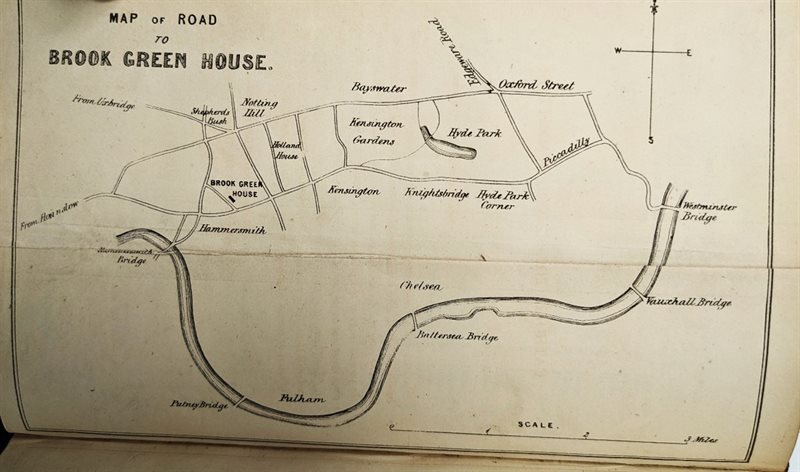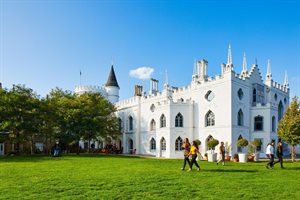St Mary’s has long served British, and international communities, developing a strong reputation for teaching excellence.
Founded in 1850 in Hammersmith as a Catholic teacher training college in 1925, St Mary’s moved to the iconic Strawberry Hill building and grounds in Twickenham. It has continued to grow in size, scope, and impact. In 2025 St Mary’s, now a full degree-awarding University, celebrates its 175th anniversary and a century since the move to Strawberry Hill.
St Mary's was founded in 1850 by the Catholic Poor-School Committee. The CPSC had recently been set up with the task of providing primary education for the growing number of children of poor Catholics in the United Kingdom. It purchased premises at Brook Green House, Hammersmith, adapting it for use as a college with accommodation for forty adult male students. This was an area that has long been associated with Catholicism, back into penal times.

Map of Brook Green, The Second Annual Report of the Catholic Poor-School Committee (London, 1849).
The ambition was to train Catholic schoolmasters on similar lines to the Brothers of Christian Instruction at Ploermel, Brittany, where English students were sent between 1848 and 1851. A French brother, Brother Melanie, was initially placed in charge of St Mary's College, until the appointment of an English principal, Rev. John Melville Glennie. The college opened with just six adult male students who had begun their training at the novitiate of the Brothers of Christian Instruction. It was expected that students would join the teaching religious order, however in 1854, in response to a shortage of suitably qualified candidates, the decision was taken to admit lay students to the college. In 1855, additional accommodation was provided for fifty lay students, and by 1860 only lay students were attending the college.
With the appointment of the fourth principal, Father William Byrne CM in 1899, the association of the college with the Congregation of the Mission (known as the Vincentians) commenced. This inaugurated a period of change and augmentation, seen in the increase in staff and student numbers, the introduction of the office of Dean, and the extension of the college premises made possible by funding from the Catholic Education Council. At the same time the college was concerned with adjusting to the requirements of the Education Acts of 1902–1903 and their effect on the development of elementary education.
In 1898 Inter-College Sports were introduced between Borough Road, St Mark's, St John's, Westminster, and St Mary's Colleges. The college magazine, The Simmarian, began a new series in 1903–1904. Originally in manuscript form, it became a printed paper in 1905 and is still published today.
 In the early twentieth century there was an increasing demand for Catholic teachers. By 1924 there were 129 resident students at the college at Brook Green. Recognising the limitations of facilities at Hammersmith, the Principal the Very Rev J.J. Doyle, CM, along with Sir John Gilbert and Sir Francis Anderton, negotiated the sale of the Hammersmith site to the neighbouring J. Lyons and Co. In 1922, and in 1923 the purchase of the Walpole-Waldegrave property at Strawberry Hill, Twickenham. The Strawberry Hill house is Britain's finest example of Georgian Gothic Revival architecture, designed as a Gothic fantasy between 1747 and 1792 by Horace Walpole, historian, writer, and collector. Along with extensive new buildings designed by S. Pugin-Powell, opened in 1927, the new Twickenham site provided overall accommodation and classroom space for around 250 students.
In the early twentieth century there was an increasing demand for Catholic teachers. By 1924 there were 129 resident students at the college at Brook Green. Recognising the limitations of facilities at Hammersmith, the Principal the Very Rev J.J. Doyle, CM, along with Sir John Gilbert and Sir Francis Anderton, negotiated the sale of the Hammersmith site to the neighbouring J. Lyons and Co. In 1922, and in 1923 the purchase of the Walpole-Waldegrave property at Strawberry Hill, Twickenham. The Strawberry Hill house is Britain's finest example of Georgian Gothic Revival architecture, designed as a Gothic fantasy between 1747 and 1792 by Horace Walpole, historian, writer, and collector. Along with extensive new buildings designed by S. Pugin-Powell, opened in 1927, the new Twickenham site provided overall accommodation and classroom space for around 250 students.